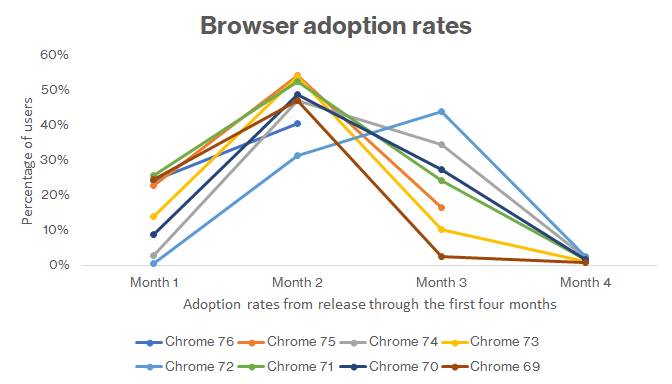Chrome 77 dropped last week, and our 209 checkpoint locations are in the process of updating or are already using the newest version of Chrome to monitor your website. That means your Web Application Monitoring and Full Page Check performance monitors are in sync with your users with the latest and greatest Chrome browser. Is your website monitoring service current?
We understand how important it is to have current browsers for your testing. Therefore, at Uptrends, we start updating our checkpoints right away, and by the second week of a new browser release, we have every Chrome browser updated. If your site has a problem with the latest release, you will know about it right away. However, other website monitoring companies aren’t as diligent with their browser updates (we will take a look at those a little later). First, let’s take a look at the Chrome update process.
Chrome’s version release process
Google releases an updated version of Chrome every six weeks with small patches to the version happening frequently. Updates include security and bug fixes, UI (user interface) enhancements, and less obvious things such as changes to the browser’s developer tools. Each rollout is designed to happen over a couple of weeks.
The major release every six weeks is called the stable release. Prior to the stable release, Google has three other releases or phases: canary, development, and beta.
- Canary is the experimental phase or sandbox version of the browser where new ideas and concepts are developed and tested.
- Development is where new features get polished and tested.
- Beta is a period where users can test the newest version before Google finalizes the version before general release.
Google releases the new stable version in stages starting with only five percent of its Chrome users. If no problems surface, Google ramps up the updates to 15 percent of users followed by 50 percent and finally 100 percent. Therefore, you have a spike in adoption rates in the following month after release.
Figure 1 shows the first four months for Chrome releases 69–76. Notice that adoption rates remain low in the release month (higher if released early in the month). Updates peak in the second month, and by month four, only about two percent of users remain on the previous version.

Browser adoption rates for monitoring companies
Uptrends updates every checkpoint within two weeks of a release. That isn’t true for many companies. We investigated several other website monitoring companies to see what version of Chrome they currently use. However, many companies do not reveal their browser versions at all; others only let you see the user agent used, which may or may not reflect the actual browser used. Here is what we found (See Table 1).
Table 1: Current Chrome browser used by other website monitoring companies as of September 13, 2019
| Monitoring company | Chrome browser version | Release date |
|---|---|---|
| AlertBot | 57 (Simulated using Firefox) | 3/9/2017 |
| Pingdom | 61 | 9/5/2017 |
| Site24/7 | 65 | 3/26/2018 |
| StatusCake | 67 | 5/29/2018 |
| AlertSite | 71 | 12/4/2018 |
| Foo | 71 | 12/4/2018 |
| NewRelic | 75 | 6/4/2019 |
| CatchPoint | 76/77 | 9/10/2019 |
| SpeedCurve/ WebPageTest |
76/77 | 9/10/2019 |
| Uptrends | 76/77 | 9/10/2019 |
Notice AlertBot doesn’t give an option for using a Chrome browser. Instead, AlertBot simulates a Chrome browser using a Firefox browser. You will also notice that Pingdom uses a Chrome browser from two years ago. NewRelic is a bit more on top of things with a version five months old. We weren’t able to verify CatchPoint directly, but they do say they begin internal testing immediately on new releases. SpeedCurve/WebPageTest is the only other company we could verify in our research using a current browser version.
We were unable to gather information from several website monitoring companies. Some notable companies include:
- UptimeRobot
- Anturis
- Uptime.com
- Monitis
- Host Tracker
On a side note, we also notice WebsitePulse still uses a Netscape browser from 19 years ago.
What is Uptrends’ Chrome update process?
Uptrends checkpoints get updated automatically the same way you probably get your browser updates. So the updates occur at the same rate as all other Chrome users.
Rather than wait and test the version after the stable release, Uptrends participates in the beta phase of Chrome’s development. By the time the stable release begins the update process, we’ve already tested the new version before it hits our checkpoints.
Why is it important to monitor your website with current browsers?
When monitoring your website for speed or function (transactions), you need to use the same browsers that your users do. So, what browsers do your visitors use? You can know for certain which browsers your visitors use with Real User Monitoring (RUM), but looking at the worldwide statistics, you get a fairly good idea. As reported by StatCounter as of August 2019, Chrome leads the pack on all devices except tablets (See Table 2).
Table 2: Browser market share by device type
| Device | Percentage of market share | |||
|---|---|---|---|---|
| Chrome | Safari | Firefox | IE/Edge | |
| Desktop | 71.15 | 5.8 | 9.52 | 9.22 |
| Mobile | 57.88 | 20.37 | .34 | .28 |
| Tablet | 22.56 | 64.59 | .62 | .17 |
| Console | .04 | – | – | 33.19 |
When testing with browsers or browser versions other than those that your visitors are using, you may not get an accurate picture of their experience. For example, in brief tests using our free Website Speed Test tool, we found results as different as 2.7 seconds between browsers when testing sites such as Amazon, Google, Apple, and Samsung. As browsers evolve, so do their performance. If your website monitoring service uses older browsers to tests your website, your test results probably don’t match your users’ experiences.
Also, with each release, there is a chance of problems that could affect your site and your business. Issues that cause Google to update users in batches, as you saw above. If your website monitoring company doesn’t use the current browser version, your site may be malfunctioning without you knowing it.
What’s new in Chrome 77?
Google focused most of the new features and changes in its latest release behind the scenes in security and bug fixes as well as several new features for developers.
User Interface Changes
You will only find small changes to the user interface in Chrome 77.
Extended Validation certificate (EV certificates) indicators discontinued
You’re probably asking, “What’s that?” Your question is also the answer to why Google and other browsers discontinued displaying the information. Previously EV certificate information appeared on the address bar next to the lock icon. The security information had no impact on a user’s decision to enter personal information on unsecured sites, and most users didn’t notice it or understand it. To free up screen real estate, Google moved the information. You can find the info by clicking on the lock icon.

Improved onboarding experience for new installations of Chrome
New installations of Chrome now guide the users through several options: adds bookmarks for major apps, default browser, and enable Chrome Sync for keeping Chrome settings the same across multiple devices.
Security fixes
Chrome 77 comes with 36 security fixes. One security fix is critical, and eight High priority. The security fixes address a vulnerability that allowed the attacker to install programs, alter and view data, and create user accounts.
Developer tools
Along with the security updates, Google introduced several new features in its Development tools.
New metrics
Chrome now comes equipped with two new metrics to help developers understand their page load a little better: Largest Contentful Paint, First Input Timing.
Largest Contentful Paint
The Largest Contentful Paint gives you information on the time it takes for the browser to render the largest visible content element. These elements tend to be images and videos.
First Input Timing
Part of the PerformanceEventTiming interface, First Input Timing tracks the timing of the availability of the page’s first interactive element. The feature reports on interactions such as key down, mouse down, pointer down followed by pointer up, and click.
New controls
Chrome 77 offers many new features. Two notable additions are the formData event and formAssociated attribute. You can learn more in Google’s video.
formData Event
The formData Event allows for JavaScript to participate in the form submission by allowing for changes to the form’s data before submit.
formAssociated attribute
The formAssociated attribute bridges the gap between native controls and custom elements by allowing the browser to treat the element like all other page elements.
Conclusion
You can trust that Uptrends is conducting your browser-based website monitoring with the most current version of Chrome available. Using the latest browsers means that you get accurate measurements of your page’s performance and transactions. By the way, did we mention that we also use current versions of Firefox and Internet Explorer? If you want to make sure you’re testing your website with current browsers, open a 30 day trial today.




